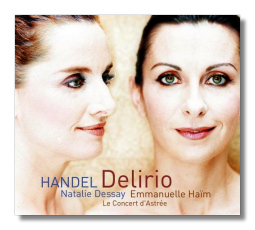
The Internet's Premier Classical Music Source
Related Links
- Handel Reviews
- Latest Reviews
- More Reviews
-
By Composer
-
Collections
DVD & Blu-ray
Books
Concert Reviews
Articles/Interviews
Software
Audio
Search Amazon
Recommended Links
Site News
 CD Review
CD Review
George Frideric Handel

Italian Cantatas
- Delirio amoroso, HWV 99
- Mi palpita il cor, HWV 132b
- Aci, Galatea, e Polifemo, HWV 72 "Qui l'augel da pianta in pianta"
Natalie Dessay, soprano
Emmanuelle Haïm, harpsichord
Le Concert d'Astrée/Emmanuelle Haïm
Virgin Classics 09463-32624-2 DDD 62:02
The "Italian cantatas" on this CD date from 1706-1710 when Handel was in Italy soaking up indigenous opera, and learning how to write vocal music in the Italian style himself. These, then, are the works of a young composer: no older than 25 years old, most likely. Two complete cantatas are presented here. In Delirio amoroso, the singer (Chloris) laments the death of Thyrsis, whom she loved, although her love was not reciprocated. She imagines going to look for him in Hades and finding him still to be cool to her. In Mi palpita il cor, now it is the singer who is in love with Chloris, who – wouldn't you know it? – is cool towards her, much to her pain, jealousy, and distraction. Between the two, we are given a lengthy aria from Handel's even lengthier Aci, Galatea, e Polifemo. In this aria, Acis hears the song of a bird, but it doesn't comfort him because he is unhappy; Galatea, in escaping Polyphemus, has run into the ocean. (The course of true love seldom runs smooth!)
Natalie Dessay is most famous for singing lyric-coloratura roles in Romantic French opera, including Gounod's Juliette and Delibes's Lakmé. She sounds very comfortable here, however, and she spools out Handel's bejeweled and stratospheric vocal lines with naturalness and a bright but plaintive tone – very French. She is not at all reticent about acting with her voice. For example, in the opening of Mi palpita il cor, one can hear her imitating the spasmodic pounding of her anguished heart. In Delirio amoroso (literally, "the madness of love"), she finds a convincing vocal equivalent for Chloris's uncertain steps and erratic thoughts. Baroque vocal music is seldom done as emotionally as this, and yet Dessay cannot be accused of stylistic improprieties any more than she can be complained about for singing these cantatas with too little expression.
Haïm and Le Concert d'Astrée don't just fade into the background. What makes these works particularly appealing is Handel's eloquent writing for solo instruments – oboe, violin, and cello. For example, in the aria from Aci, Galatea, e Polifemo, the oboe and the violin plaintively combine to depict not just the happy bird that flies from branch to branch, but also the singer's downcast emotional state. The instrumental accompaniments are no less important to setting the mood and supporting the story than is the singer herself. Together, Dessay and Le Concert d'Astrée beguile the ear and almost convince the listener that these silly librettos remain relevant, even though the era of "nymphs and shepherds" is long past.
The engineering is well-balanced and amply detailed. Virgin's booklet contains sung texts and translations, and a worthwhile essay about the music. My only complaint concerns the garish booklet photography, which smacks more of skin and eye care product advertising than Handel's music. One example joins half of Dessay's face to the opposite half of Haïm's like a before-and-after photo. Is someone trying to tell us that these two musicians perform as if they were one person, or simply that some faces need oil-free moisturizers and others don't?
Copyright © 2006, Raymond Tuttle




















